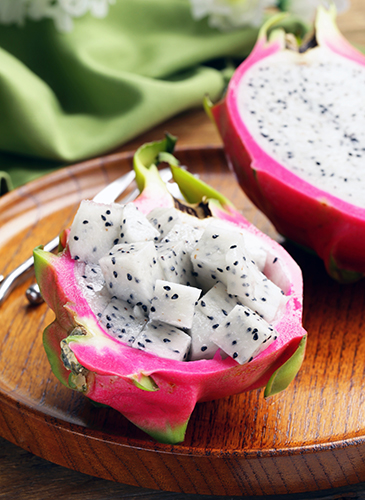
Dragon fruit has taken the culinary world by storm with its vibrant colors and intriguing taste. This exotic fruit, often mistaken for a citrus due to its refreshing flavor, is actually a member of the cactus family. Its unique appearance and nutritional profile have made it a popular choice for both health-conscious individuals and adventurous foodies alike. In this article, we’ll delve into the fascinating world of dragon fruit, exploring its origins, nutritional benefits, taste, growing conditions, and culinary uses.
This comprehensive guide will provide you with all the information you need to understand this remarkable tropical fruit better. From its botanical classification to its diverse applications in the kitchen, we’ll cover every aspect of dragon fruit, dispelling common misconceptions along the way.
What is Dragon Fruit?
Dragon fruit, scientifically known as Hylocereus undatus, is a cactus fruit native to Central and South America. It belongs to the Cactaceae family, which encompasses various types of cacti. The fruit grows on climbing vines that can reach impressive lengths, often adorned with large, showy flowers that bloom at night.
Dragon fruit comes in two main varieties: red-skinned with white flesh and yellow-skinned with white or red flesh. Both varieties share a sweet, slightly tart flavor with a subtle hint of pear or melon. The flesh is speckled with tiny black seeds, which are edible and add a pleasant crunch to the texture.
Despite its tropical origins, dragon fruit can be cultivated in various climates worldwide, including subtropical regions. Its popularity has surged in recent years, making it a readily available fruit in many supermarkets and specialty stores.
Nutritional Benefits of Dragon Fruit
Dragon fruit is not only delicious but also packed with essential nutrients. It’s a good source of vitamins, minerals, and antioxidants, contributing to overall health and well-being.
Vitamins: Dragon fruit is rich in vitamin C, an important antioxidant that boosts the immune system and protects against cell damage. It also contains smaller amounts of B vitamins, such as thiamin, riboflavin, and niacin, which play crucial roles in energy metabolism and nerve function.
Minerals: This tropical fruit provides a good source of minerals like iron, magnesium, and phosphorus. Iron is essential for red blood cell production, while magnesium supports muscle and nerve function. Phosphorus contributes to bone health and energy production.
Antioxidants: Dragon fruit is loaded with antioxidants, including betalains, which give the fruit its vibrant pink and red color. These potent compounds help protect cells from damage caused by free radicals, reducing the risk of chronic diseases.
Taste and Appearance
Dragon fruit’s unique appearance and refreshing taste have captivated food enthusiasts worldwide. Its bright pink or yellow skin, often adorned with green scales, creates a visually stunning contrast against its white or red flesh.
The flesh itself is soft and juicy, with a sweet, slightly tart flavor reminiscent of pear or melon. Some describe it as having a subtle hint of kiwi or watermelon. The tiny black seeds scattered throughout the flesh add a pleasant crunch and contribute to the fruit’s overall texture.
Growing Conditions
Dragon fruit thrives in warm, tropical climates with plenty of sunshine. It requires well-drained soil and moderate watering.
Climate: Dragon fruit plants prefer temperatures between 70°F and 85°F (21°C and 29°C). They are sensitive to frost and cold temperatures, making them unsuitable for colder regions.
Soil: Well-drained soil is crucial for dragon fruit cultivation. The soil should be slightly acidic with a pH range of 6.0 to 7.0. Adding organic matter to the soil can improve drainage and fertility.
Watering: Dragon fruit plants need regular watering, especially during the growing season. However, it’s important to avoid overwatering, as this can lead to root rot. Allow the soil to dry slightly between waterings.
Culinary Uses
Dragon fruit’s versatility in the kitchen has made it a popular ingredient in various dishes and beverages.
Fresh Fruit: The most common way to enjoy dragon fruit is simply by slicing it open and scooping out the flesh. It can be eaten on its own as a refreshing snack or added to salads, yogurt parfaits, and smoothies for a burst of flavor and color.
Desserts: Dragon fruit’s sweet taste and vibrant hue make it an excellent addition to desserts. It can be used to create colorful ice cream, sorbet, cakes, and pies. The flesh can also be pureed and used as a topping for pancakes, waffles, or crepes.
Beverages: Dragon fruit juice is a popular refreshing drink, often blended with other fruits like mango or pineapple. It can also be added to cocktails for a unique twist.
Conclusion
Dragon fruit, despite its name, is not a citrus fruit but a member of the cactus family. Its vibrant appearance, sweet and slightly tart flavor, and impressive nutritional profile have made it a beloved tropical delicacy worldwide. From its origins in Central and South America to its cultivation in various climates, dragon fruit has captured the hearts and taste buds of food enthusiasts everywhere. Whether enjoyed fresh, incorporated into desserts, or blended into refreshing beverages, this exotic fruit offers a delightful culinary experience and a wealth of health benefits.
